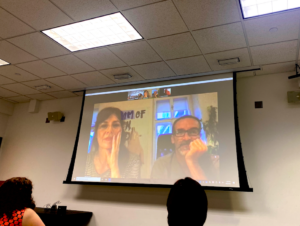By Chloe Teall
This week’s theme was one that I have really been looking forward to: community curation. We initiated class by trying to come up with our own working definition of community curation. In order to achieve a more complete understanding of how this practice can be done successfully, we looked to this week’s group of spotlight presentations for real-world examples of previous exhibits.
I was one of the presenters this week, and my PowerPoint was based on an article by Yvonne Ng about three organizations that were developing community-centered archives from the Black Lives Matter movement. Retrospectively, I am delighted to have chosen this particular topic because it is very relevant to our work with the Museum of Broken Relationships.

As part of our work with the Museum of Broken Relationships, during class this week we met with co-founders Olinka Vištica and Dražen Grubišić who very graciously took time out of their day to call us and speak with us in detail about the work that the museum does. They explained that the genesis of their project was in fact, their own breakup with each other. Olinka and Dražen probably did not anticipate that the end of their romantic relationship would really just be the beginning of their professional relationship that has been going strong for about 16 years.
Like the archives, but very unique from most other curatorial methods, the Museum of Broken Relationships is completely dependent upon audience donations for its collections. Both the Museum of Broken Relationships and the Black Lives Matter archives I read about also vow to store and preserve all of the items that people submit, which in and of itself speaks to how much the curators value the stories and input of the communities they’re working with. Additionally, the archives and the museum do not modify the submitted items – the nature of the display may add a layer of context, however, the presentation maintains the words, images, and other aspects of the original donation.
Dražen gave us a live in-depth tour of the Museum of Broken Relationships in Zagreb, which provided valuable insight into the subtle and important ways that the curators have taken artistic liberty. What I thought was really interesting is that the museum is somewhat categorized by emotion: first, the viewer sees some humorous items, then some angry items, then some very heavy and sad items, and eventually reminds you to “leave with an open heart”.
Other sources we read suggested that when working closely with such emotionally charged material, it is crucial that the curators are able to remain empathetic and flexible so that the voice of the community speaks over the motives of the institution. If the curators are too rigid, the exhibit will lose its authenticity. However, if curators aren’t involved at all, it makes it impossible for the stories to be viewed in a meaningful way. Trust is a key element in community-based curation because both the museum and the community it’s working with depend on each other for the success of the exhibit.
While on the call with Olinka and Dražen, our previous discussions about artists as curators and curators as artists managed to sneak their way back into the conversation. Dražen feels very strongly that he is approaching his work with the museum as an artist, not a curator, and that despite the name, it is more of an art project than a museum for them. This being Dražen’s stance had me wondering, is submitting an object, then, a curatorial act or an artistic one?
We wrapped up our Zoom call with them with a mutual expression of excitement about our future exhibition. It was energizing to hear just how much Olinka and Dražen trusted our class with our contributions to the Museum of Broken Relationships Indianapolis. In fact, they were delighted to have the opportunity for fresh, young minds because of the potential for us to maybe come up with some out-of-the-box ideas. I think I can speak for many of my peers when I say that I am definitely up to the challenge.
Chloe Teall is a first-year graduate student in the Visual Arts program

